Blog Archives
Our Beloved and Revered Satguru Sivaya Subramuniyaswami
Attained Maha Samadhi on November 12th, 2001
Click to read for Details.
Gurudeva’s Statement on Sept. 11th
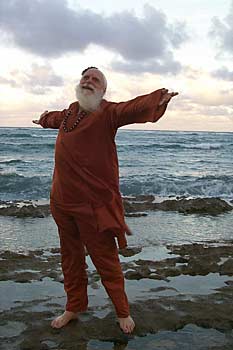
Many people are asking about their association with the Guru Paramapara now that Gurdudeva has transitioned to Siva’s feet…
We have Gurudeva’s very own direct advice on this important issue, and share it with all of our TAKA visitors today. It’s just 90 seconds, but very clearly settles the matter of what to do if your living Satguru departs this Earth. It is his answer to a CyberCadet’s question given on May 22, 2000. You can listen to the audio file or read the transcript just below:
May 22, 2000
Title: Meaning of Initiation
Category: The Guru
Live talk at: /taka/past/2000/May/May_22_2000/
A question from a cyberspace cadet from W. T. net.
Well, Parashag wants to know if he’s taken initiation from a guru and
that guru has passed on into Mahasamadhi, no longer in this physical
body, does he have to retake that initiation with another living
guru?
And do you always have to have an initiation from a living guru?
Many people have imaginary initiations from gurus that are not living but the meaning of initiation is: the beginning of learning. A student may apply to many universities for entrance but once one says, “Yes, come in,” that is similar to an initiation and it begins many years of close association and learning. So you can’t dream your way through the university or dream an entrance into the university. It has to be real, live, human, physical and a lot of work follows an initiation. Any responsible guru will have successors. And the successor is bound to carry on the study and give the next initiation and then the next teaching after that. If the guru has not been farsighted enough to appoint a successor, then you are free to choose another guru who is alive.
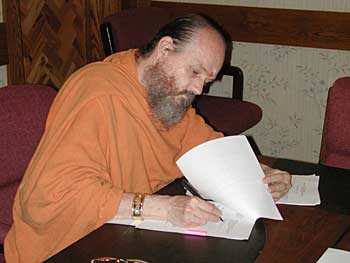
Our Satguru Bodhinatha Veylanswami in the “Cedar Room” where Gurudeva worked for so many years, communicating with devotees, monks and devas in this same space.
Cybertalk: Bodhinatha give his final speech that he has prepared for the coming Martin Lurther King Day. Since the September 11 events, people are distrusting others.
That leads to hatred and a desire to inflict violence. Education will fix
the problem. Southern Poverty Law Center, http://www.splcenter.org/
distributes literature about tolerance and a pledge of tolerance.
Cybertalk Ends”
For more information about listening to Gurudeva’s talks online and to hear them in other formats, click here.
And click here for an Index to All Past CyberTalks.
Study Gurudeva’s teachings
every day. Visit the Master Course site!
Bodhinatha will be happy to hold “Prasnottara Satsang” — “Questions and Answers” over the telephone with any Hindu religious societies, Hindu youth groups, Radio talk show hosts etc. All you need is a phone with a speaker and an enthusiastic audience. Arrangements may be made in advance by sending email to Sadhaka Mahadevan
If you are experiencing any problems listening to the audio, please to go our Audio FAQ page for sound geeks and follow the directions there.
 |
|
|
 |
||
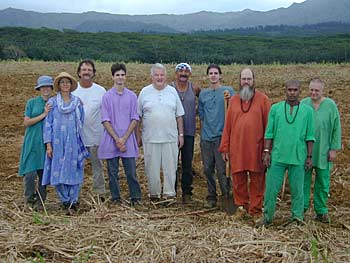
A humble but historic beginning for the monastery’s new land occured this past retreat with the monks and some Kauai devotees went out into the fields to hand plant the very first crop. Left to right, Sitara Alahan, her mother Ishani Alahan, father, Durvasa Alahan, then Sivananda Katir, Brahmachari Rajadeva Alahan, Tandu Sivanathan, Markandeya Sendan from California, visiting his brother, Sannyasin Arumugaswami, Sadhaka Tyaganatha and Sadhaka Haranandinatha.
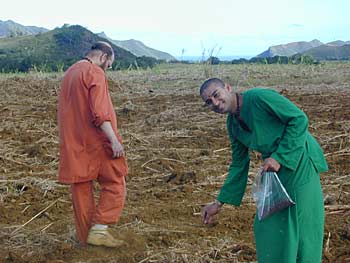
And, Sadhaka Mahadevan who was behind the camera in the above picture… together they planted a couple of acres of sunn hemp, which is a green manure crop, meaning it adds nutrients to the soil and improves the land’s ability to grow things. The government provided the seed. Sunn hemp is extensively used in India to restore fertility to the soil between rice crops. The fiber is used to make rope

Tandu is following the seeders, kicking dirt to cover the seeds just sown in the furrows.

It took the team two hours to plant just over two acres with 30 pounds of seed. The resulting harvest of 2,000 pounds of seed will be used to improve soil on other parts of the property.

Mount Waialeale behind the finished field.
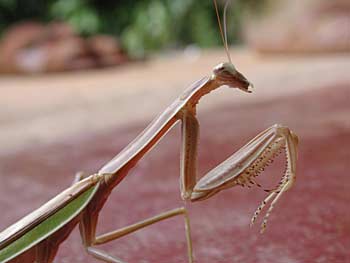
A praying mantis watches the events with interest.
 The Remarkable Vision |
Iraivan Temple Progress Update |
Join this historic undertaking. Please contribute generously. Sponsor a stone today! |

At the top of some pillars are the Potagai, representing the banana tree with its hanging banana flowers. Here are the banana flowers themselves being carved individually.
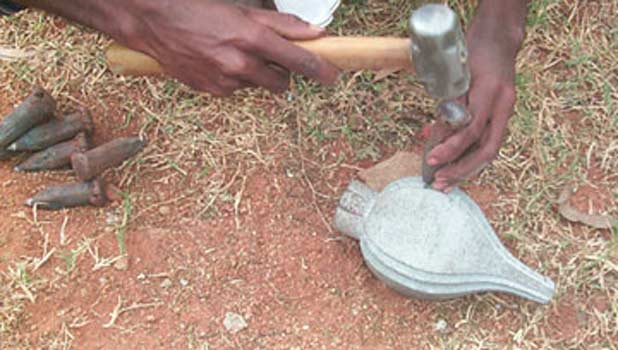
Each one will be set into a small slot after the pillar is erected.

The initial base forms are carved out and then the sthapati will come by and draw the lines for the fine work.
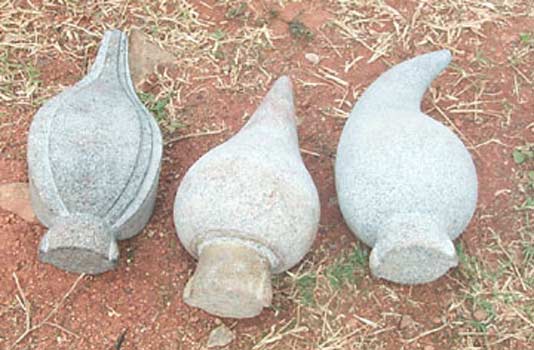
Please donate generously to the Iraivan temple project and be a participant in this grand undertaking. Email iraivan@hindu.org for more information

|
Study Gurudeva’s teachings.
|
transcription begins
Date: January_02_2002
Title: The Roots of Martin Luther King
Category: Good Conduct
Duration: 18 min., 35 seconds
Date Given: January 1, 2002
Given by: Bodhinatha
I am not sure how long ago it was that Gurudeva participated in the Martin Luther King holiday, Martin Luther King Day event in Hawaii and there is a new one coming up. They have invited me, so I was giving some thought. I have never been to a Martin Luther King Day event and I may have to speak. So, I am starting to think about it and doing a little research. I thought I would share some of my preliminary thoughts.
Dr. King first encountered the teachings of Gandhi when he went to the Theological Seminary and was quite impressed. He even went to India, he spent five weeks in India – I didn’t realize that – in 1959, as a guest of Prime Minister Nehru, in efforts to study and learn more about Gandhi’s philosophy and techniques of non-violence.
On the India trip, King met with the followers of Gandhi. During these discussions, he became more convinced than ever that non-violent resistance was the most potent weapon available to oppressed people in their struggle for freedom. We are all familiar with that general idea, Gandhi’s principle of non-violence. Of course, he is talking about non- violence in a political setting, something we are not encountering today.
We generally think of non-violence or ahimsa in the sense of a principle we apply in our personal life. But it was taken up as a way of resisting. In other words, as an alternative to a violent form of resistance for an oppressed group, a non-violent form of resistance.
So as we all know, Dr. King’s efforts helped change the situation in this country and discrimination laws that existed in the Southern States aren’t there anymore. In fact, there are anti-discrimination laws throughout the US, regarding housing and equal employment at this time.
But of course, it didn’t eliminate discriminatory attitudes. The laws are gone, the laws against discrimination but the attitudes of discrimination of course are still present in the world today, they haven’t gone away as we know. Those attitudes are dislike, distrust, even hate of others based on religion, ethnicity or nationality. And of course as we know, watching the News these days America is certainly disliked by a lot of people around the world. A strong sense of dislike and hate exists in many people towards America. Of course that is a form of discrimination. People are discriminating against people in America based upon their nationality, without giving much thought to anything more than that. So in a minute, we will look at a Hindu principle which can deal with that problem as effectively as the principle of non-violence was used to overturn discrimination laws and a Hindu principle to overturn discriminatory attitudes.
But first I thought it was interesting in my research, as we all know, the United States is receiving lots of immigrants from many countries and the State of California is the favorite place. So there was lots of information on the web that I could find in just a few minutes.
The problem of discrimination, just by having an increase in pluralism, tends to lessen. In other words, if you have two groups only, it is easy for them build up these attitudes. When you have ten groups, it gets harder. When you have fifty groups, the rules change. You just don’t have the kind of stand-offs that you have when you just have a couple of groups.
I thought it was interesting, in California there are thirty-two countries immigrants are coming from. Thirty-two different countries and these immigrants are speaking fifty different languages. Fifty different languages, imagine dealing with that! I will just read the top ten. Of course the first one we could guess is Mexico speaking Spanish. The second one is Philippines, Tagalongs is the name of the language. The third one is Vietnam, it is the third most country of immigrants to California, Vietnam, speaking Vietnamese. After that the Peoples Republic of China where we have Mandarin Chinese. Then we have Iran speaking Farsi. Korea speaking Korean. El Salvador speaking Spanish. Taiwan speaking Mandarin Chinese. Then we get India, they list the languages, Hindi, Bengali, Telugu, Marathi, Tamil, Urdu, Gujarathi, Malayalam, Kannada, Oriya, Punjabi, Assamese, Kashmiri, and Sindhi. Tenth is Laos, speaking Laotian.
Isn’t that interesting? Such a diversity is coming into the country and by itself helps reduce this problem of discrimination and dislike. Because you get so many groups, you don’t polarize or create strong feelings between just two or three groups.
I am sure you are all asking yourselves all ready, “What is this other Hindu principle?” As non-violence was effective as a form of protest against laws against discrimination, what is the Hindu principle which helps eliminate attitudes of discrimination?
It is the idea that everyone is divine, every single person is a divine being and that this divinity is not conditional. Meaning it exists no matter what. No matter what religion they belong to, they are divine. No matter what beliefs they hold, they are still a divine being. No matter how they act. If they do the most violent actions, does that make them not divine? No, they are still divine. Every single being on the planet is a divine being.
This is a very interesting point of view because not everyone thinks that way. But certainly if you look at everyone as a divine being and really see the divinity in them, you can’t discriminate against them. You are just seeing something spiritual in them. You have no ability to discriminate against something spiritual.
It is one of the big differences when we hear President Bush talk about ‘evil’. That always kind of gets to me and I think what an interesting point of view and how different from the Hindu point of view. Saddam Hussein is this great evil. President Bush does not consider Saddam Hussein a divine being. He doesn’t think of him as a spiritual being. He doesn’t think the essence of Saddam Hussein is the same as the essence of me. No, he doesn’t think that way. So therefore, it is easy to dislike Saddam Hussein and feel, “Well, he is not a divine being. Therefore what we do to him is different than what we do to people who act in a good way.”
But of course that is not the Hindu perspective. The Hindu perspective is, just because you act in an evil way doesn’t change the fact that you are a divine being. If you act in a good way, if you act in an evil way, if you are non violent, if you are violent, that is your action. It is not who you are in your essence. Your essence is always divine no matter what you do, no matter what you believe.
Isn’t that a wonderful point of view? It is a great point of view to help eliminate discrimination. Because from that point of all you see is the divinity within everyone.
Gurudeva, of course, in working with the Vision Kauai group, stepped that principle down. He didn’t say, “Well, Hindus believe in divinity of all. So therefore, well this and that.” Gurudeva didn’t reference Hindu scripture in working with the Vision Kauai group. But he referenced Hindu principles without calling them Hindu principles.
Based upon this idea that each person is a divine person and therefore should be looked at with love and compassion, no matter what they do, no matter what ethnic group they are in, no matter what religion they are. He created the idea, ‘One island, many peoples, all Kauaians.’ It is saying the same thing but in a secular way, ‘One island, many peoples, all Kauaians.’
It doesn’t matter what ethnic group you are part of, it doesn’t matter what religion you are part of. We are all one group, all Kauaians. Meaning, we should treat each other in the same way, no matter what our ethnic group, no matter what our religion. It doesn’t matter. Everyone should be treated the same, with the same kindness and caring and helpful attitudes that we have toward anyone on the island, people we know on the island. We should have it toward people we don’t know on the island, because they are all Kauaians..
Taking that a step deeper, reading from ‘Living with Siva’ on ahimsa. Gurudeva relates the two principles we are talking about, the principle of ahimsa and the divinity of everyone, in a very nice way.
“The Rishis who revealed the principles of dharma, divine law in Hindu scripture knew full well the potential of human suffering and the path which could avert it. To them, a one spiritual power flowed in and through all things in the Universe, animate and inanimate, conferring existence by its presence. To them life was a coherent process leading all souls without exception to enlightenment and no violence could be carried to the higher reaches of that ascent. These rishis were mystics whose revelations disclosed the cosmos in which all beings exist in interlaced dependence. The whole is contained in the part and the part in the whole. Based on this cognition, they taught a philosophy of non-difference of self and other. Asserting that in the final analysis, we are not separate from the world as manifest forms nor from the divine which shines forth in all things, all beings, all peoples. From this understanding of oneness arose the philosophical basis for the practice of non injury and Hinduism’s ancient commitment to it. We all know that Hindus, who are one-sixth of the human race today, believe in the existence of God everywhere as an all-pervasive, self effulgent energy and consciousness. This basic belief creates the attitude of sublime tolerance and acceptance toward others. Even tolerance is insufficient to describe the compassion and reverence the Hindu holds for the intrinsic sacredness within all things. Therefore, the actions of all Hindus are rendered benign or ahimsa. One would not want to hurt something which one revered. On the other hand, when the fundamentalist of any religion teaches an unrelenting duality based on good and evil, man and nature or god and devil. This creates friends and enemies. This belief is a sacrilege to Hindus because they know that the attitudes which are the by-product are totally dualistic and for good to triumph over that which is alien or evil, it must kill out that which is considered to be evil. The Hindus look at nothing as intrinsically evil,” even Saddam Hussein. No, I just added that. Even Osama Bin Laden. No, it doesn’t say that either!
“The Hindus look at nothing as intrinsically evil. To him the ground is sacred, the sky is sacred, the sun is sacred. His wife is a goddess, her husband is a god, their children are devas, their home is a shrine. Life is a pilgrimage to mukti or liberation from rebirth which once attained is the end to reincarnation in a physical body. When on a holy pilgrimage, one would not want to hurt anyone along the way, knowing full well the experiences on this path are of one’s own creation, though may be acted out through others.”
That is a wonderful tying together of the two principles. We wouldn’t hurt, we can’t hurt that which we revere. We can’t hurt something that we look at as divine. It even takes it to the point of oneness, which is the next step in the process. In other words, the way I initially presented it was separate, we see the divine in each person, we look deeply enough we see the soul nature, one’s intrinsic nature which is divine, within everyone.
But as Gurudeva points out in this writing, everyone really isn’t separate. Separateness only exists in the lower states of mind. When we look at it from a deeper perspective, from an inner perspective, from a higher state of consciousness we only see a one spiritual force, a one divinity. This is recognized in Vedanta in a nice way. They have a tradition, you may have seen some letters from Vedanta Swamis, one to another. When they start the letter they don’t say “Dear Swami so and so”. They never say that. How do you start the letter? You say, “To my own self, beloved Atman”. You are addressing the letter to yourself, you don’t acknowledge that there is a separate person, in that way of starting a letter. To my own self, beloved self, to the one Atman. So you don’t recognize a separateness.
Of course, that is what this teaching is based upon and its essence is that we are not separate. If we hurt another person, we are only hurting our self and if we help another person, we are only helping our self.
There is only one divinity that permeates us all and that is a perspective that we can have when we go deeply enough within ourselves. It not just a concept, it can be a perspective, an experience that we hold when we look out at other people. We don’t see them as separate from us. We feel we are a one being. A one spiritual being.
transcription ends
|
MORE UPLIFTING THINGS |
Innersearch 2002 in Hawaii!
Plans are in the works for a wonderful innersearch program located right here on the island of Kauai in the summer (July/August) of 2002. Be prepared for a wonderful spiritual experience in paradise with classes, meditations, seminars and wonderful ceremonies at the Siva temple of Kauai’s Hindu Monastery. Details are being worked on and we will be informing prospective participants in the new future of the exact dates. If you would like to be on the mailing list to be informed, please send your full contact information, name, address, phone and email to |
|

|
Check our children and youth section for new items for the young and young at heart! | |
|
1. SIGN OUR GUESTBOOK and receive a FREE GIFT |
||
| 2. Newest Book: LIVING WITH SIVA | ||
|
3. Visiting KAUAI’S HINDU MONASTERY |
||
|
4. Contribute to THANK YOU, GURUDEVA FUND |
||
From Our Gurus' Teachings
Archives are now available through 2001. Light colored days have no posts. 1998-2001 coming later.
